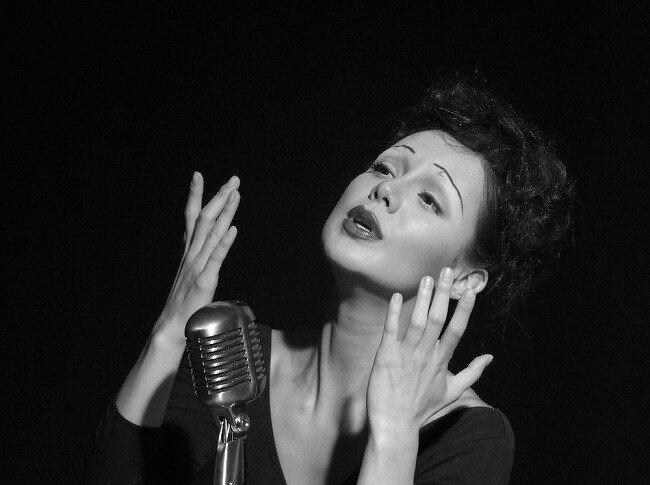Singing In The French Style
This is adapted from a talk I gave at LA Opera in 2006.
Edith Piaf, Photo Credit
A 2-minute history of the world:
Long ago and far away, when nations were isolated from one another by mountain ranges and oceans and miles, cultures formed, languages formed, musical and artistic style formed, influenced by things like weather and food and wealth. Even with such distance and space between cultures, people wanted to travel and taste different food and hear different music, so they walked or rode horses or rode in a carriages long distances to satisfy their curiosity (at least those with the time, money and inclination did). Then something amazing happened in the late 18th century, the steam engine was invented. Railroads popped up in the early 19th century and people started visiting far away places more often. It became easier to bring back recipes and songs and clothing styles to try out at home. This was the beginning of the great industrial age and beginning of the end for pure cultural styles.
As a reaction to bombardment from other cultures caused by trains and steam boats, national styles grew strong in the late 19th and early 20th centuries. We all know that colorful era in music we call “the rise of nationalism.” National styles in music peaked between the World Wars. In western music we are mostly talking about European styles, and especially those with strong musical traditions like the German, Russian, Italian, English and French styles of music that once flourished. It was thought that by labeling the styles and magnifying them and taking them around the world proclaiming their heritage, this musical style might survive the attack from all fronts. Then along came the airplane and after WWII as technology sped ahead with telephones and computers and made the world smaller and smaller the national styles started their slow but steady decline. They became more and more mixed with other cultures, influenced by political and social trends and transformed into new cultural styles. Today we see only shades, we hear only echoes of those isolated cultures that once held sway.
No place is it more interesting to note this history of national styles than in opera. Thankfully we began recording opera singers in 1900 so we got to preserve many of the great examples of national styles. Still today, if one looks hard enough, one can find pockets of national style that have been carefully preserved and continue to be practiced especially in the song literature. And who better to keep the national style than the French who have so carefully preserved the purity of their language even today. This does help them preserve their musical heritage.
What is the French Style?
From the listener’s point of view: (speaking of Manon)
Victoria de los Angeles , “Adieu Notre Petite Table”
Bright, operetta style, lyric coloratura
Timbre girlish and shallow
Diction crystal clear
Vowels unmodified – even high
Can project comfortably in middle range
Easy upper register, little or no opulent bloom like expected today
Slender, penetrating sound capable of charm, rhythmic subtlety and verbal nuance
From the singer’s point of view:
Attack – coordinated like Italian but less precise (aspirate, glottal, coordinated)
Breath Management – natural , instinctive, like speech – based on relaxation
Vowel Formation – preserve the sound of the language above all, smile mouth opening, jaw not dropped at hinges – vocalize on bright [a] as in parle. Bright, reedy, thin quality. Very active lips within the smile.
Resonance – buccal and nasal mostly
“Chanter dans le masque” – tonal ideas and national linguistic tendencies
Tongue elevated – tip touching the front lower teeth, inverted concave, exaggerated
Laryngeal Positioning – elevated partially because of the bright
Posture has chin slightly elevated to get “out of the way of the sound”
Vibrato – rapid, hard to separate from thin, nasal quality
Italians call it voce di capra “goat voice”
Vowel modification – heavy cover of German school decisively rejected, little or no vowel modification in men – prefer to flip to falsetto to preserve the vowel, sometimes women do modify to keep tone quality consistent in upper registers – French singers suffer from “voix blanche” because of this
Tone: committed to lightness of vocal weight and brightness of tonal color – physical involvement is less than other schools, focus on relaxation/natural voice
Thus the French-trained schools create more light, high voices than low ones.
Colortura, lyric colortura, soubrette sopranos
Ténor léger
Baryton lyrique
Basse - clarity of resonance in direct contrast to barrel sound of German bass, usually faster vibrato “The lyricism of a well-schooled baritone voice of the French School pleases in its subtlety, grace and ease of production. Unfortunately, neither category in the French school can produce the necessary power and dramatic force required in much of the operatic literature for baritone and bass.” P. 166
Few dramatic sopranos or tenors due to the hesitancy to engage the body enough to get those loud high tones
“The French ear, cultivated by national attitudes towards vocalism is willing to accept a much lighter timbre … than does any other national ear.” P. 151
The role of language in national pedagogies:
“Among teachers of singing, the nature of the several languages is often assumed to be an indirect but major source of the differences in tonal ideals which distinguish the four national schools of singing. Only national temperament, which in generally thought to shape every field of artistic endeavor, is cited as being a more significant contributor to the aesthetics of vocalized sound within the four schools”
So if you look at your handout you’ll see the French style as compared to the other national styles.
Most singers prefer Italian!
What has happened to the French Style on the opera stage?
bigger houses – the light high thin sound cannot project well enough
modern orchestral sound – more density and sound – French vocalism cannot compete
projected titles make nuances of language irrelevant
in Manon, as in other operatic roles, the image of women has dictated preferred sound – Manon went from being a flighty charming girl in the 20s most easily shown with the French style, to the working woman after WWII, to the free spirit in the 60’s and 70’s to the driven woman of the 80’s needing a heavier and darker tone to the “material girl” of today who is totally in charge of her world – needing a substantial voice that can stretch at will and make the orchestra wait. (Great article on this listed on your hand out)
Listen to these recordings and see if you can hear the changes. Beverly Sills, Renée Fleming.
In conclusion: we no longer have the purest of the national styles that once existed through what is there can still be heard in bits on the operatic stage and in full bloom in the salon. What we have now is being called the International Style. It will be interesting to see where it goes from here.


